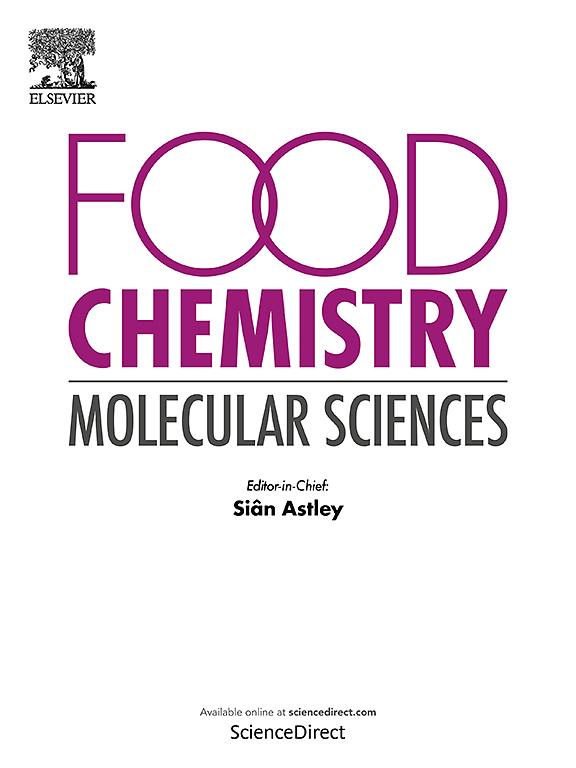Application of bacterioruberin from Arthrobacter sp. isolated from Xinjiang desert to extend the shelf-life of fruits during postharvest storage
IF 4.1
Q2 FOOD SCIENCE & TECHNOLOGY
引用次数: 0
Abstract
Post-harvest losses and rapid fruit ripening at room temperature are major challenges in preserving fruit quality. This study aimed to reduce such losses by applying a red carotenoid pigment, bacterioruberin extracted from an Arthrobacter sp. The carotenoid was characterized as bacterioruberin and its derivative tetra anhydrous bacterioruberin (λmax 490 nm), and an m/z value of 675 and 742 (M+ 1H)+1. The annotated LIPID MAP demonstrated the presence of over 360 isoprenoids annotated transcripts. The compound exhibited significant antioxidant activity, with an IC50 of 22 μg/mL, iron chelation and antibacterial activities indicating its potential as a natural preservative. When applied to grapes, peaches, and apricots, bacterioruberin (2 %) effectively prevented spoilage for six days at room temperature. Statistical analysis using one-way ANOVA revealed a significant correlation (p = 0.05) between treated and control groups in subjective quality attributes. Computational investigation with phospholipase D and VQ22 motif protein further supported the preservative potential of bacterioruberin.
应用新疆沙漠节肢杆菌菌环菌素延长果实采后贮藏期。
采后损失和果实在室温下快速成熟是保持果实品质的主要挑战。本研究利用从节杆菌属中提取的一种红色类胡萝卜素类细菌红素(bacterioruberin)来减少这一损失。类胡萝卜素的表征为bacterioruberin及其衍生物四无水细菌红素(λmax 490 nm),其m/z值分别为675和742 (m + 1H)+1。带注释的脂质图谱显示存在超过360个带注释的类异戊二烯转录本。该化合物具有显著的抗氧化活性(IC50为22 μg/mL)、铁螯合活性和抗菌活性,表明其具有天然防腐剂的潜力。当应用于葡萄、桃子和杏子时,在室温下有效地防止了6天的腐败。单因素方差分析显示,治疗组与对照组在主观质量属性上有显著相关(p = 0.05)。利用磷脂酶D和VQ22基序蛋白的计算研究进一步支持了菌绿蛋白的防腐潜力。
本文章由计算机程序翻译,如有差异,请以英文原文为准。
求助全文
约1分钟内获得全文
求助全文
来源期刊

Food Chemistry Molecular Sciences
Agricultural and Biological Sciences-Food Science
CiteScore
6.00
自引率
0.00%
发文量
83
审稿时长
82 days
期刊介绍:
Food Chemistry: Molecular Sciences is one of three companion journals to the highly respected Food Chemistry.
Food Chemistry: Molecular Sciences is an open access journal publishing research advancing the theory and practice of molecular sciences of foods.
The types of articles considered are original research articles, analytical methods, comprehensive reviews and commentaries.
Topics include:
Molecular sciences relating to major and minor components of food (nutrients and bioactives) and their physiological, sensory, flavour, and microbiological aspects; data must be sufficient to demonstrate relevance to foods and as consumed by humans
Changes in molecular composition or structure in foods occurring or induced during growth, distribution and processing (industrial or domestic) or as a result of human metabolism
Quality, safety, authenticity and traceability of foods and packaging materials
Valorisation of food waste arising from processing and exploitation of by-products
Molecular sciences of additives, contaminants including agro-chemicals, together with their metabolism, food fate and benefit: risk to human health
Novel analytical and computational (bioinformatics) methods related to foods as consumed, nutrients and bioactives, sensory, metabolic fate, and origins of foods. Articles must be concerned with new or novel methods or novel uses and must be applied to real-world samples to demonstrate robustness. Those dealing with significant improvements to existing methods or foods and commodities from different regions, and re-use of existing data will be considered, provided authors can establish sufficient originality.
 求助内容:
求助内容: 应助结果提醒方式:
应助结果提醒方式:


